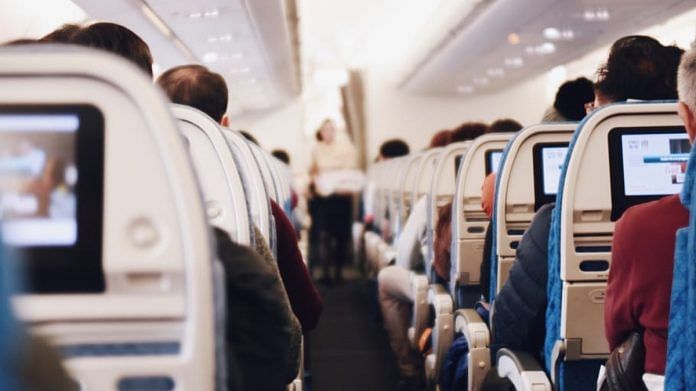New Delhi: Alaska Airlines’ Boeing 737-9 is set to test a ‘Curtain of Air’ technology that it claims can enhance the safety of passengers by creating invisible barriers against SARS-CoV-2 laden viral particles.
An air curtain works by using fans to forcefully push air in the downward direction. This invisible barrier prevents air from circulating while allowing people to freely move between two areas.
Such curtains are already in use in several settings such as malls, restaurants and airports. The air curtain, for example, prevents hot air from entering a space, keeping the indoor area cool with a relatively lesser amount of energy spent by cooling devices.
The air curtain also serves as a barrier against suspended pollutants, dust particles and pathogen-laden droplets of moisture — which is why they may be useful to protect passengers from infecting each other.
Research now shows that being in a closed, unventilated environment with one infected person increases the chance of everyone in that space getting infected, irrespective of the physical distance between them.
Small-sized droplets of moisture expelled when an infected person breathes, talks, sings, coughs or sneezes can float around in the air and put others in the same closed space at risk of infection.
This makes a flight cabin, which at a time can have up to 220 passengers confined together for several hours, an ideal environment for Covid super spreader events.
Air curtains between the passengers’ seats would ensure that each person is effectively sitting in an invisible bubble, and is less likely to be exposed to aerosols from another infected person.
Also read: How to reduce risk of indoor Covid transmission? MIT online app has some answers
What studies say
Although research in this field is still emerging, studies have looked into the use of air curtains to reduce the spread of exhaled aerosols.
For example, in a study by a team from Southeast University in China, researchers evaluated the numerical parameters that would make such air curtains a viable form of protection against the spread of aerosols.
The researchers found that a circular air curtain around a person minimises the risk of contaminated aerosols from spreading beyond the air curtain.
Similarly, another study showed that portable air curtains, worn around the head much like plastic face shields, can effectively provide both inward and outward protection and serve as an effective personal protective equipment (PPE) mitigating human-to-human transmission of virus infection like Covid-19.
The technology is among the 20 others that will be tested to enhance safe and sustainable travel under Boeing’s ecoDemonstrator programme.
Other technologies include a new fire extinguishing agent for aircraft that significantly reduces effects on the ozone layer, testing and evaluating concepts that can help reduce noise on current engines and “inform designs for next-generation models,” and other means to reduce fuel consumption and carbon emissions.
The ecoDemonstrator programme was launched in 2012 and focuses on accelerating “innovation by taking promising technologies out of the lab and testing them in the air to solve real-world challenges for airlines, passengers and the environment,” according to a Boeing statement. This is the eighth aircraft to be tested for innovative technology.
A US-based design firm had earlier worked with Boeing to develop 3D-printed nozzles that produce a curved “blade” of fresh air that surrounds the passenger at the side and in front.
(With inputs from Taran Deol)
(Edited by Neha Mahajan)
Also read: Covid does spread some distance through air, update to 2020 Chinese restaurant study says



